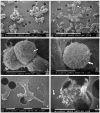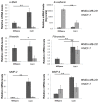Collagen Fiber Array of Peritumoral Stroma Influences Epithelial-to-Mesenchymal Transition and Invasive Potential of Mammary Cancer Cells
- PMID: 30736469
- PMCID: PMC6406296
- DOI: 10.3390/jcm8020213
Collagen Fiber Array of Peritumoral Stroma Influences Epithelial-to-Mesenchymal Transition and Invasive Potential of Mammary Cancer Cells
Abstract
: Interactions of cancer cells with matrix macromolecules of the surrounding tumor stroma are critical to mediate invasion and metastasis. In this study, we reproduced the collagen mechanical barriers in vitro (i.e., basement membrane, lamina propria under basement membrane, and deeper bundled collagen fibers with different array). These were used in 3D cell cultures to define their effects on morphology and behavior of breast cancer cells with different metastatic potential (MCF-7 and MDA-MB-231) using scanning electron microscope (SEM). We demonstrated that breast cancer cells cultured in 2D and 3D cultures on different collagen substrates show different morphologies: i) a globular/spherical shape, ii) a flattened polygonal shape, and iii) elongated/fusiform and spindle-like shapes. The distribution of different cell shapes changed with the distinct collagen fiber/fibril physical array and size. Dense collagen fibers, parallel to the culture plane, do not allow the invasion of MCF-7 and MDA-MB-231 cells, which, however, show increases of microvilli and microvesicles, respectively. These novel data highlight the regulatory role of different fibrillar collagen arrays in modifying breast cancer cell shape, inducing epithelial-to-mesenchymal transition, changing matrix composition and modulating the production of extracellular vesicles. Further investigation utilizing this in vitro model will help to demonstrate the biological roles of matrix macromolecules in cancer cell invasion in vivo.
Keywords: breast cancer; collagen type I; epithelial-to-mesenchymal transition; extracellular matrix; scanning electron microscope.
Conflict of interest statement
The authors declare no conflict of interest.
Figures











Similar articles
-
Extracellular Matrix-Mediated Breast Cancer Cells Morphological Alterations, Invasiveness, and Microvesicles/Exosomes Release.Cells. 2020 Sep 4;9(9):2031. doi: 10.3390/cells9092031. Cells. 2020. PMID: 32899718 Free PMC article.
-
Long filopodia and tunneling nanotubes define new phenotypes of breast cancer cells in 3D cultures.Matrix Biol Plus. 2020 Jan 25;6-7:100026. doi: 10.1016/j.mbplus.2020.100026. eCollection 2020 May. Matrix Biol Plus. 2020. PMID: 33543024 Free PMC article.
-
The phenotype of cancer cell invasion controlled by fibril diameter and pore size of 3D collagen networks.Biomaterials. 2015 Jun;52:367-75. doi: 10.1016/j.biomaterials.2015.02.022. Epub 2015 Mar 3. Biomaterials. 2015. PMID: 25818443
-
The matrix environmental and cell mechanical properties regulate cell migration and contribute to the invasive phenotype of cancer cells.Rep Prog Phys. 2019 Jun;82(6):064602. doi: 10.1088/1361-6633/ab1628. Epub 2019 Apr 4. Rep Prog Phys. 2019. PMID: 30947151 Review.
-
Stromal elements for tumor diagnosis: a brief review of diagnostic electron microscopic features.Ultrastruct Pathol. 2005 May-Aug;29(3-4):305-18. doi: 10.1080/01913120590951301. Ultrastruct Pathol. 2005. PMID: 16036885 Review.
Cited by
-
Substrate Type and Concentration Differently Affect Colon Cancer Cells Ultrastructural Morphology, EMT Markers, and Matrix Degrading Enzymes.Biomolecules. 2022 Nov 30;12(12):1786. doi: 10.3390/biom12121786. Biomolecules. 2022. PMID: 36551219 Free PMC article.
-
ΕGFR/ERβ-Mediated Cell Morphology and Invasion Capacity Are Associated with Matrix Culture Substrates in Breast Cancer.Cells. 2020 Oct 8;9(10):2256. doi: 10.3390/cells9102256. Cells. 2020. PMID: 33050027 Free PMC article.
-
Colorectal Cancer Cell Invasion and Functional Properties Depend on Peri-Tumoral Extracellular Matrix.Biomedicines. 2023 Jun 22;11(7):1788. doi: 10.3390/biomedicines11071788. Biomedicines. 2023. PMID: 37509428 Free PMC article.
-
Extracellular Matrix-Mediated Breast Cancer Cells Morphological Alterations, Invasiveness, and Microvesicles/Exosomes Release.Cells. 2020 Sep 4;9(9):2031. doi: 10.3390/cells9092031. Cells. 2020. PMID: 32899718 Free PMC article.
-
Trends in extracellular matrix biology.Mol Biol Rep. 2023 Jan;50(1):853-863. doi: 10.1007/s11033-022-07931-y. Epub 2022 Nov 7. Mol Biol Rep. 2023. PMID: 36342580 Free PMC article. Review.
References
-
- Garcia M.G., Bayo J., Bolontrade M.F., Sganga L., Malvicini M., Alaniz L., Aquino J.B., Fiore E., Rizzo M.M., Rodriguez A., et al. Hepatocellular carcinoma cells and their fibrotic microenvironment modulate bone marrow-derived mesenchymal stromal cell migration in vitro and in vivo. Mol. Pharm. 2011;8:1538–1548. doi: 10.1021/mp200137c. - DOI - PubMed
Grants and funding
LinkOut - more resources
Full Text Sources
Miscellaneous

